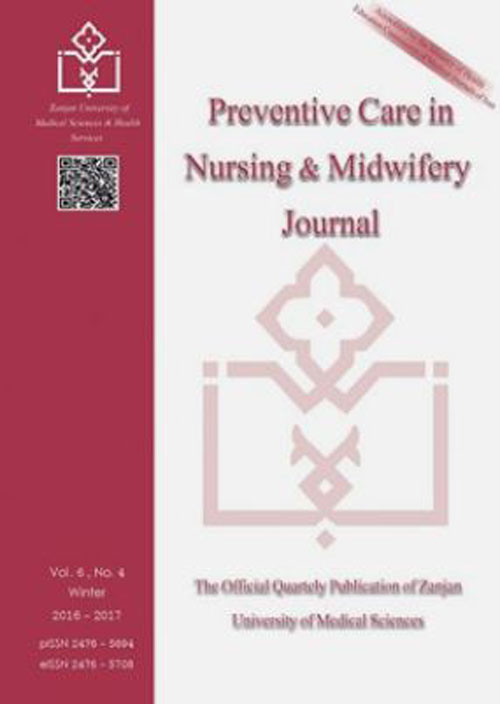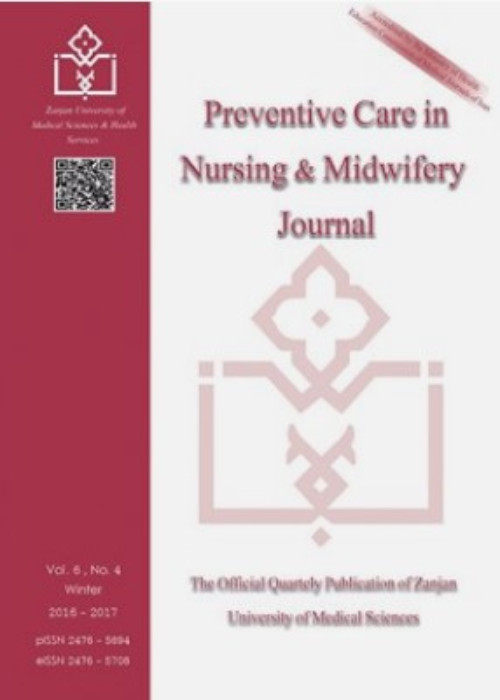فهرست مطالب

Preventive Care in Nursing & Midwifery Journal
Volume:12 Issue: 1, Spring 2022
- تاریخ انتشار: 1400/10/20
- تعداد عناوین: 8
-
-
Pages 1-10Background
Cancer stigma is an important issue in cancer patients and affects the follow-up, adherence, and acceptance of treatment. Therefore, it is necessary to take action to reduce cancer stigma.
ObjectivesThis study aimed to determine the effect of group training of emotional intelligence components of Salovey and Mayer’s (1990) model on stigma in cancer patients.
MethodsThis clinical trial with a pretest-posttest design was performed on 52 patients with cancer admitted to Omid Oncology Hospital in Mashhad, Iran, during 2018-2019. The participants were selected by the convenience sampling method and randomly allocated to two groups of intervention (n=25) and control (n=27). The intervention group received emotional intelligence group training based on Salovey and Mayer’s (1990) model during 10 sessions. The control group received routine care during the study. The data collection tool was the Cancer Stigma Scale. Data analysis was performed by SPSS software (version 25) using the paired t-test and independent t-test. A p-value of less than 0.05 was considered the significant level.
ResultsBased on the results, there was no significant difference between the intervention and control groups regarding the mean total stigma score in the pretest (P=0.46). However, there was a significant difference between the two groups regarding the changes in the mean total stigma score after the intervention (P<0.001).
ConclusionEmotional intelligence group teaching can be effective in reducing stigma in cancer patients. Therefore, it is suggested to use emotional intelligence teaching to reduce stigma in cancer patients in oncology hospitals.
Keywords: emotional intelligence, group teaching, cancer, stigma -
Pages 11-19Background
Healthcare-associated infections (or nosocomial infections) impose many health problems and costs on patients and hospitals. Hand hygiene compliance is one of the most effective ways to control and prevent the spread of nosocomial infections.
ObjectivesThis study aims to investigate the knowledge, attitude and performance of nursing students towards hand hygiene in medical and surgery wards in Zanjan teaching hospitals, 2019.
MethodsThe current descriptive cross-sectional study was conducted on 50 junior and senior undergraduate nursing students of Zanjan Nursing and Midwifery faculty who were selected based on convenience sampling. Students' knowledge and attitude on hand hygiene were assessed through a standard questionnaire recommended by the World Health Organization and a researcher–made one. The study has been conducted from 12.10.2019 to 9.02.2020. Data were analyzed using Chi-square test, Fisher's exact test and paired t-test by SPSS Software version 22.
ResultsThe results of the study demonstrated that 62% of students had moderate knowledge about hand hygiene. Based on the findings only 12% had a positive attitude to hand hygine.
ConclusionSince the unfavorable knowledge and attitude of students about hand hygiene and also the unavailability of essential facilities for hand hygiene increase the risk of transmission of healthcare associated infections by students, so to prevent cross-infection ,it is recommended to improve facilities concerning hand hygiene, training and supervision.
Keywords: hand hygiene, nursing students, knowledge, attitude, performance -
Pages 20-28Background
Separation anxiety disorder (SAD) is one of the most common mental disorders in childhood. Inattention to treat this disorder can be a risk factor for other childhood and adolescence mental disorders.
ObjectivesWe aimed at investigating the effectiveness of child-parent relationship therapy (CPRT) in children with SAD.
MethodsThis quasi-experimental study was conducted in a pre-test and post-test design with a control group. The research population consisted of preschool and first-grade students in primary schools in Zanjan, Iran. Twenty-four mothers whose children were diagnosed with anxiety disorder were selected nonrandomly (volunteers to participate in the research), but they were randomly assigned to the control and intervention groups. The Children's Symptoms Inventory questionnaire (CSI-4) was used to diagnose separation anxiety. Also, the parent-child relationship assessment questionnaire (MCRE), Sherer General Adult Inventory Questionnaire, and Parent Stress Index Questionnaire (PSI) were completed before and after the treatment. The intervention group received ten sessions of 2 hours of group training on CPRT, while the control group did not receive any intervention. One-way analysis of covariance (ANCOVA) and multivariate analysis of covariance (MANCOVA) were used to analyze the data.
ResultsThe results of covariance analysis showed that the severity of anxiety symptoms were significantly decreased in the experimental group (p>0.05). It also reduced mothers' stress (83%), increased mothers’ self-efficacy (77%), and improved mother-child relationships.
ConclusionChild-parent relationship therapy can be an effective intervention in reducing the symptoms of child separation anxiety, and it can be employed as an educational protocol for reducing tension, increasing mothers' self-efficacy, and improving mother-child relationships. Due to the limited sample size of the present study, it is suggested that a study with a larger sample size be conducted to confirm the findings of this study.
Keywords: separation anxiety, parent-child relationship therapy, tension, self-efficacy, mother-child relationship -
Pages 29-36Background
Insufficient evidence exists regarding the causes of adverse birth outcomes among women with previous cesarean sections (C-Section).
ObjectivesThis study aimed to explore women’s perspectives on childbirth care services leading to maternal near-miss (MNM) events.
MethodsFollowing a narrative design, 12 women with a previous C-section who had an episode of MNM during childbirth or postpartum period referring to a tertiary referral hospital in Zahedan city, Iran, were chosen using purposive sampling. Face-to-face interviews were used to collect data. Data were analyzed using the six-phase guide to thematic narrative analysis approach.
ResultsTwo themes related to childbirth care services leading to maternal near-miss events were extracted: (1) ‘Ineffective communication’ (Ignoring the patient's words, Insensitive listener, and Non-critical thinking listener) and (2) ‘Inappropriate care’ (implementation of unnecessary or inappropriate care and early discharge).
ConclusionAn audit system is necessary to provide objective information on the domains related to care provision and help timely feedback to healthcare providers to improve the quality of care.
Keywords: near-miss, healthcare, childbirth, health facilities -
Pages 37-44Background
Cancer can affect the quality of life of patients. Family support is essential in this disease.
ObjectivesThis study aimed to determine the relationship between family functioning and quality of life in patients with gastric cancer.
MethodsThis cross-sectional study was performed on patients with gastric cancer at the Valiasr Medical Center in Zanjan, Iran, in 2018 using the census method. A specific standard questionnaire for the quality of life of cancer patients and a McMaster family assessment device were used to collect information. The descriptive analysis and Pearson’s correlation coefficient were used to analyze data by SPSS software version16.
ResultsIn total, 108 patients were assessed. The family functioning of the patients was assessed in the normal range and was partially good in all dimensions. The mean of general function (2.97 of 4) and affective responsiveness dimensions (2.31 of 4) was the weakest and the best, respectively. The overall quality of life, symptoms, and function [42.20 (2.65), 69.77 (7.23), 43.43 (7.38)] were at an unfavorable level. There was a significant inverse relationship (P<0.001) between the overall quality of life and the dimensions of family functioning: problem solving (r=-0.623), communication (r=-0.74), roles (r=-0.588), and behavior control (r=-0.718). A significant inverse relationship was also found between the overall quality of life and general family function (r=-0.577) (P<0.001).
ConclusionThe study showed the association between quality of life and family function in patients with cancer. Improving family function in these patients using different methods is recommended.
Keywords: family function, quality of life, gastric cancer -
Pages 45-53Background
Blended learning is the thoughtful integration of online and face-to-face learning, which is widely accepted in nursing education.
ObjectivesDespite its importance and complicacy, few studies investigated this issue. This study aimed to extend knowledge regarding factors contributing to effective blended learning in nursing education.
MethodsFollowing the Attride-Stirling content analysis method, we searched PubMed, Elsevier, Emerald, Science Direct, ProQuest, and Springer databases and national databases of SID and MagIran to identify relevant studies using various combinations of online, semi-online, hybrid, and mixed keywords from 2005 to 2018.
ResultsFour main themes were identified, content, context, educational activities, and evaluation. Nine identified organizer themes were as follows: Content objectives, flexibility, control and evaluation, technological capabilities, support system, teaching activities, learning activities, performance feedback, and evaluation methods. Finally, 23 basic themes codes were obtained as factors that should be embedded in the online nursing curriculum.
ConclusionBlended learning is a rational and flexible method to improve the educational performance of nursing students. However, it should be based on need assessment, appropriate planning and execution, and evaluation and feedback.
Keywords: content analysis, hybrid curriculum, nursing -
Pages 54-59Background
The importance of clinical competency in nurses indicates the necessity of evaluating this criterion for nurses working in Covid-19 and non-Covid-19 departments.
ObjectivesComparison of clinical competency in nurses working in Covid-19 and non-Covid-19 departments of university hospitals in Zanjan city in 2020.
MethodsFollowing a convenient sampling method, this cross-sectional study recruited 220 registered nurses working at hospitals affiliated to the Zanjan University of Medical Sciences with at least six months of work experience. Data were collected using a demographic information form and competency inventory for registered nurses (CIRN). Mann Whitney U test was used to compare study groups.
ResultsThere was a significant difference between nurses working in Covid-19 and non-Covid-19 departments concerning clinical competency, so that those in Covid-19 departments were more competent (p-value=0.001).
ConclusionThe observed difference requires more attention and particular interventions, including promoting teamwork, engaging staff in decision-making processes, job supports, reducing conflicts and role ambiguities, and increasing control over employment-related events
Keywords: clinical competency, exposure, covid-19 -
Pages 60-69Background
Exposure to death and the resulting anxiety is a significant dimension of the mental health of patients suffering from chronic diseases, including heart failure.
ObjectivesIllness perception affects adherence to health-promoting behaviors and health outcomes. Hence, the purpose of this study was to investigate the effect of a perception-based intervention on death anxiety in patients with heart failure.
MethodsFollowing a randomized clinical trial design, 120 patients suffering from heart failure, recruited using convenient sampling, were categorized into two groups of control and intervention using the randomized minimization method. The intervention group received three 30-minute sessions of training, while the control group only received routine interventions. Data were collected using a demographic information checklist, brief illness perception questionnaire (BIPQ), and Templer Death Anxiety Scale. Data analysis was administered by independent t-test, paired t-test, chi-square, and Wilcoxon tests using SPSS version 22.
ResultsThere was a significant difference between the study groups concerning anxiety scores before and after the intervention (P<0.001). Death anxiety scores before the intervention were not significantly different between the two groups (P=0.640), but there was a statistically significant difference in death anxiety scores after the intervention (P<0.001).
ConclusionRegarding the importance of death anxiety in patients with heart failure, this study demonstrated the importance of using perception-based interventions.
Keywords: illness perception, death anxiety, heart failure


